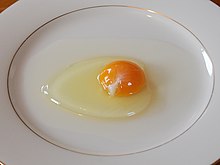Avidin
| Avidin family | |||||||||
|---|---|---|---|---|---|---|---|---|---|
| |||||||||

Avidin is a
In its tetrameric form, avidin is estimated to be 66–69 k
Functional avidin is found in raw egg, but depending on the amount of heat it is exposed to during cooking, the quantity of molecules available for binding biotin can change. The natural function of avidin in eggs is not known, although it has been postulated to be made in the oviduct as a bacterial growth inhibitor, by binding biotin helpful for bacterial growth. As evidence for this, streptavidin, a related protein with equal biotin affinity and a very similar binding site, is made by certain strains of Streptomyces bacteria, and is thought to serve to inhibit the growth of competing bacteria, in the manner of an antibiotic.[6]
A non-
Discovery

Avidin was discovered by
Applications
| Avidin | |||||||
|---|---|---|---|---|---|---|---|
| Identifiers | |||||||
| Organism | |||||||
| Symbol | AVD | ||||||
UniProt | P02701 | ||||||
| |||||||
| Unless otherwise specified, "avidin" the biomedical reagent is chicken avidin. | |||||||
Research in the 1970s helped establish the avidin-biotin system as a powerful tool in biological sciences. Aware of the strength and specificity of the avidin-biotin complex, researchers began to exploit chicken avidin and streptavidin as probes and affinity matrices in numerous research projects. allowing the transfer of the avidin-biotin system to a range of biotechnological applications. Today, avidin is used in a variety of applications ranging from research and diagnostics to medical devices and pharmaceuticals.
Avidin's affinity for biotin is exploited in wide-ranging biochemical assays, including
Avidin immobilized onto solid supports is also used as purification media to capture biotin-labelled protein or nucleic acid molecules. For example, cell surface proteins can be specifically labelled with membrane impermeable biotin reagent, then specifically captured using an avidin-based support.[citation needed]
Modified forms
As a basically charged glycoprotein, avidin exhibits non-specific binding in some applications. Neutralite avidin, a deglycosylated avidin with modified arginines, exhibits a more neutral isoelectric point (pI) and is available as an alternative to native avidin, whenever problems of non-specific binding arise. Deglycosylated, neutral forms of chicken avidin are available through Sigma-Aldrich (Extravidin), Thermo Scientific (NeutrAvidin), Invitrogen (NeutrAvidin), and e-Proteins (NeutraLite).
Given the strength of the avidin-biotin bond, dissociation of the avidin-biotin complex requires extreme conditions that cause protein denaturation. The non-reversible nature of the avidin-biotin complex can limit avidin's application in affinity chromatography applications where release of the captured ligand is desirable. Researchers have created an avidin with reversible binding characteristics through nitration or iodination of the binding site tyrosine.[18] The modified avidin exhibits strong biotin binding characteristics at pH 4 and releases biotin at a pH of 10 or higher.[18] A monomeric form of avidin with a reduced affinity for biotin is also employed in many commercially available affinity resins. The monomeric avidin is created by treatment of immobilized native avidin with urea or guanidine HCl (6–8 M), giving it a lower dissociation KD ≈ 10−7M.[19] This allows elution from the avidin matrix to occur under milder, non-denaturing conditions, using low concentrations of biotin or low pH conditions. For a single high affinity biotin binding site without crosslinking, a monovalent version of avidin's distant relative, streptavidin, may be used.[20]
Blocking of biotin binding
The thermal stability and biotin binding activity of avidin are of both practical and theoretical interest to researchers, as avidin's stability is unusually high and avidin is an antinutrient in human food.[21] A 1966 study published in Biochemical and Biophysical Research Communications found that the structure of avidin remains stable at temperatures below 70 °C (158 °F). Above 70 °C (158 °F), avidin's structure is rapidly disrupted and by 85 °C (185 °F), extensive loss of structure and loss of ability to bind biotin is found.[22] A 1991 assay for the Journal of Food Science detected substantial avidin activity in cooked egg white: "mean residual avidin activity in fried, poached and boiled (2 min) egg white was 33, 71 and 40% of the activity in raw egg white." The assay surmised that cooking times were not sufficient to adequately heat all cold spot areas within the egg white. Complete inactivation of avidin's biotin binding capacity required boiling for over 4 minutes.[23]
A 1992 study found that thermal inactivation of the biotin binding activity of avidin was described by
The biotin-binding properties of avidin were exploited during the development of
See also
References
External links
- Egg-stremely useful interaction[dead link]—Structure article at the Protein Data Bank
